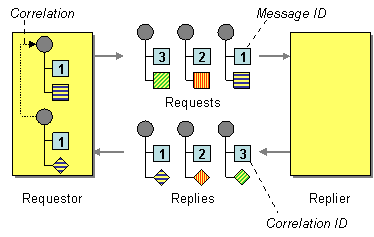Fuse 6 is no longer supported
As of February 2025, Red Hat Fuse 6 is no longer supported. If you are using Fuse 6, please upgrade to Red Hat build of Apache Camel.Chapter 6. Message Construction
Abstract
The message construction patterns describe the various forms and functions of the messages that pass through the system.
6.1. Correlation Identifier
Copy linkLink copied to clipboard!
Overview
Copy linkLink copied to clipboard!
The correlation identifier pattern, shown in Figure 6.1, “Correlation Identifier Pattern”, describes how to match reply messages with request messages, given that an asynchronous messaging system is used to implement a request-reply protocol. The essence of this idea is that request messages should be generated with a unique token, the request ID, that identifies the request message and reply messages should include a token, the correlation ID, that contains the matching request ID.
Apache Camel supports the Correlation Identifier from the EIP patterns by getting or setting a header on a Message.
When working with the ActiveMQ or JMS components, the correlation identifier header is called
JMSCorrelationID. You can add your own correlation identifier to any message exchange to help correlate messages together in a single conversation (or business process). A correlation identifier is usually stored in a Apache Camel message header.
Some EIP patterns spin off a sub message and, in those cases, Apache Camel adds a correlation ID to the Exchange as a property with they key,
Exchange.CORRELATION_ID, which links back to the source Exchange. For example, the Splitter, Multicast, Recipient List, and Wire Tap EIPs do this.
Figure 6.1. Correlation Identifier Pattern
